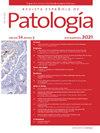High-risk neuroblastoma: ATRX and TERT as prognostic markers and therapeutic targets. Review and update on the topic
IF 0.5
Q4 Medicine
引用次数: 0
Abstract
High-risk neuroblastoma continues to show a very high mortality, with a 5-year survival rate of 50%. While MYCN amplification is the main genetic alteration associated with high-risk tumours, other molecular mechanisms, such as alterations in ATRX and TERT, remain poorly understood.
ATRX and TERT biomarkers, which are associated with a more aggressive neuroblastoma pattern, should be considered for accurate prognostic stratification.
We highlight the promising results of the clinical trial involving the combination of adavosertib and irinotecan, which encourages further clinical trials with adavosertib targeting NB with ATRX mutations. Preclinical results with BET inhibitors (OTX015 and AZD5153) and with 6-thio-2′-deoxyguanosine, targeting NB with TERT mutations, are promising. Both represent future therapeutic targets, emphasizing the need to prioritize research using these models.
高危神经母细胞瘤:ATRX和TERT作为预后标志物和治疗靶点。回顾和更新主题。
高危神经母细胞瘤的死亡率仍然很高,5年生存率为50%。虽然MYCN扩增是与高危肿瘤相关的主要遗传改变,但其他分子机制,如ATRX和TERT的改变,仍然知之甚少。ATRX和TERT生物标志物与更具侵袭性的神经母细胞瘤模式相关,应考虑用于准确的预后分层。我们强调了涉及adavosertib和伊立替康联合的临床试验的有希望的结果,这鼓励了adavosertib靶向ATRX突变NB的进一步临床试验。靶向TERT突变NB的BET抑制剂(OTX015和AZD5153)和6-硫代-2′-脱氧鸟苷的临床前结果很有希望。两者都代表了未来的治疗目标,强调了优先使用这些模型进行研究的必要性。
本文章由计算机程序翻译,如有差异,请以英文原文为准。
求助全文
约1分钟内获得全文
求助全文
来源期刊

Revista Espanola de Patologia
Medicine-Pathology and Forensic Medicine
CiteScore
0.90
自引率
0.00%
发文量
53
审稿时长
34 days
 求助内容:
求助内容: 应助结果提醒方式:
应助结果提醒方式:


